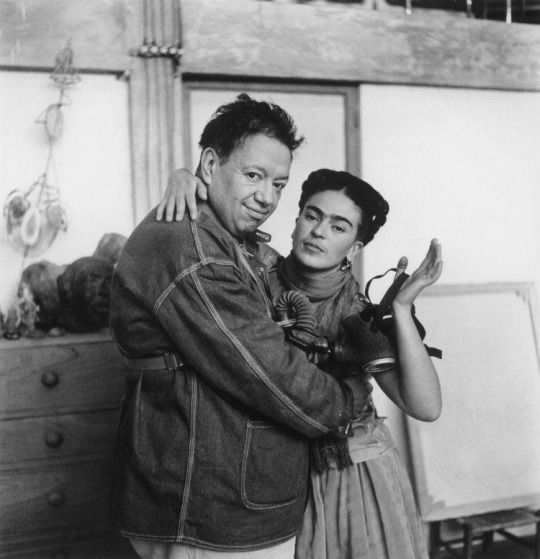Five of Our Favorite Artist Couples
From lifetime lovers to more temporary trysts
Artists are caricatured as passionate, eccentric, and reckless—and that’s when they’re not in love. We’re celebrating this Valentine’s Day by featuring five of our favorite artist couples. Some are iconic, some less so. Some were lovers for their whole lives, some for just a few years. But each coupling captures a moment in time, and, for better or worse, shows the extremes of what life can be.

1. Frida Kahlo and Diego Rivera
Today, Frida Kahlo stands as a feminist icon. But her persona had not always been so front and center. For years, in fact, she was known only as the painter Diego Rivera’s wife (who just so happened to also make art). The two were formally introduced at a party thrown by the Italian-American photographer Tina Modotti (who Frida had met through the Mexican Communist Party) in 1928. Rivera was 20 years her senior, and her physical opposite—large and unwieldy, as round as he was loud. A bit over a year later they were married, and thus began decades of tumultuous love. They would take other lovers, fight, and even divorce for a year before remarrying. Their discord brought Frida to the edge of death; after one of his affairs she attempted suicide. As hard as it is to imagine the life they shared, it’s even harder to imagine the legacies they would have left if they’d never met.

2. Lee Krasner and Jackson Pollock
If any artist couple is known as much as Frida and Diego, it’s Lee Krasner and Jackson Pollock. Like Frida and Diego, the woman was only given her due as an artist years after she’d earned it. Unlike Frida and Diego, however, the Pollock could not have reached the celebrity he had if it hadn’t been for Kranser. Before Krasner dedicated herself to her own art, she would be Pollock’s handler. “Jack the Ripper” might have had a brazen presence on the canvas, but he was famously shy off of it. Krasner’s forcefulness would open the world’s eyes to Pollock’s work—a fame that would, in one way or another, lead to his demise. This would be a devastating moment in Krasner’s life (and much of the art world), but it would finally be a chance for her to come into her own as an artist.

3. Georgia O’Keeffe and Alfred Stieglitz
Georgia O’Keeffe and Alfred Stieglitz met in 1916, when he was in his 50s and she was just 28. Unlike Frida and Diego, and, more so, Pollock and Krasner, O’Keeffe’s and Stieglitz’s styles didn’t seem to overlap an inch. Stieglitz was a photographer who paved the way for the medium. Often he would use O’Keeffe as his model. O’Keeffe is known for her sublime, floral paintings, as well as her ability to “capture the emotion and power of objects through abstracting the natural world” (The Art Story). Today she is known as the mother of American Modernism. For two artists, they sure wrote a lot; their correspondences cover over 25,000 sheets of paper. Their relationship lasted until Stieglitz’s death, in 1946. (You can see their work juxtaposed side by side in our playlist “Stieglitz and O’Keeffe: A Love Story.”)

4. Man Ray and Lee Miller
Man Ray (born Emmanuel Radnitzky) was one of the most unclassifiable artists of the first half of the 20th century. He considered himself a painter but is known for pioneering new media—like photograms, or photographs made without a camera—all while taking part, informally, in the Surrealist and Dada movements. In 1929, the Surrealist photographer-to-be Lee Miller moved to Paris to be Ray’s assistant. Ray was resistant at first, but was soon taken with Miller’s confidence and self-possession. The two would work in tandem, developing photographic techniques, like solarization (an effect caused by severe overexposure). Their styles were so alike that it’s frequently thought many works credited to Ray should actually bare Miller’s name. Their collaboration wasn’t made for a lifetime though; in 1932, Miller left him. You might say it lasted but a flash.

5. Leonora Carrington and Max Ernst
Here at Meural, we love everything Leonora Carrington. In fact, we named one of the styles of our Meural Canvas after her. Her life was long and wide; born in 1917, she lived until 2011, contributing along the way to Surrealism with both her paintings and her fiction. The way she met the German surrealist Max Ernst might be taken straight from a cheesy film about two Surrealist artists—by seeing his work first, in an exhibition. A year later, in 1937, they met at a party, and it wasn’t long before Ernst separated from his wife. The two collaborated in their work—while they could. Ernst was swept up in the winds of World War II, first for being a “hostile alien” and then, after he was let free, for producing “degenerate art.” He escaped again, but left Carrington behind, seeking refuge in America. There he would eventually marry one of the biggest names in art: Peggy Guggenheim. (And after they divorced, he married the American artist Dorothea Tanning.) It suffices to say that Carrington had a hard time of all of this; first she fled to Spain, where she was hospitalized for psychiatric trauma, and then to Mexico. It wasn’t three years that the two were together; it’s hard to see their relationship as anything but true love, truncated.


